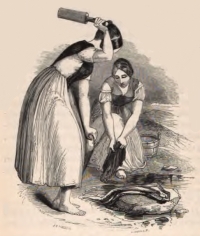-
History of:
- Resources about:
- More:
- Baby walkers
- Bakehouses
- Bed warmers
- Beer, ale mullers
- Besoms, broom-making
- Box, cabinet, and press beds
- Butter crocks, coolers
- Candle snuffers, tallow
- Clothes horses, airers
- Cooking on a peat fire
- Drying grounds
- Enamel cookware
- Fireplaces
- Irons for frills & ruffles
- Knitting sheaths, belts
- Laundry starch
- Log cabin beds
- Lye and chamber-lye
- Mangles
- Marseilles quilts
- Medieval beds
- Rag rugs
- Rushlights, dips & nips
- Straw mattresses
- Sugar cutters - nips & tongs
- Tablecloths
- Tinderboxes
- Washing bats and beetles
- Washing dollies
- List of all articles
Subscribe to RSS feed or get email updates.
Katty took a pailful of soiled linen to the spot where the stream formed a little pool, and where the villagers had fixed a broad and flat "beetling" stone.
Patrick Kennedy, Legendary Fictions of the Irish Celts, 1891
Clothes...were first soaked in warm suds in a half-barrel made into a tub - to loosen the dirt. Then they were lifted to a battling block, resembling a butcher's block, and pounded with a batler, a wooden stick. Warm water was constantly poured on them, and very little dirt was left. Such as remained was scrubbed away by a washboard in a tub of suds.
Florence Warfield Sillers, History of Bolivar County Mississippi, 1948
If you would have the esteem credit and reputation of a compleat Laundry-Maid, you must observe these following directions. ...you must take care of all the Linen in the house ... be careful that your Tubs and Copper, or whatever else you make use of be kept clean, and in good repair...
Hannah Woolley, The Compleat Servant-Maid, 1677
Before there were washboards . . .
Washing beetles, laundry bats, beetle-stones, possing-sticks, dollies

 "Vintage" washboards with a corrugated metal or glass surface for rubbing clothes
clean are quite a modern laundry tool, from the inventive 19th century. Beating
the laundry against a rock with a stick, stone, or board is a more ancient way of
getting the dirt out.
"Vintage" washboards with a corrugated metal or glass surface for rubbing clothes
clean are quite a modern laundry tool, from the inventive 19th century. Beating
the laundry against a rock with a stick, stone, or board is a more ancient way of
getting the dirt out.
The washing bats, also known as beetles (for beating) or battledores, in the photos are 18th and 19th century English designs, similar to the implement in the 20th century Polish painting below, or the 19th century engraving right, or this Albanian "spade", or this thousands-of-years-old laundry bat from ancient Egypt.
You might pound a heap of cloth in a river, pond or trough, and spread it You might pound a heap of cloth in a river, pond or trough, and spread it on a beetle-stone or wooden battling-block, to be beaten with, or without, soap. Bats might also be used on a washing stock, a board on legs. Cylindrical baseball bat styles were used as well as the kind with a flat surface, square or a long rectangle like a cricket bat - in the UK and USA and elsewhere. (Some people now distinguish them by calling the flat-sided ones bats or battledores and the round ones beetles, but I suspect this is a recent search for "logic" in the names. For centuries they have been treated as simple alternatives - "batyldoure, or wasshyng betylle" in the Promptorium Parvulorum c1440 - and as ever we must allow for regional variations too.)
Trampling the laundry with feet was another possibility, with bare feet or wearing wooden clogs:
... commonly to be seen by the sides of the river ... in all the parts of Scotland where I have been ...women with their coats [petticoats] tucked up, stamping, in tubs, upon linen by way of washing ...
Edward Burt, Letters from a Gentleman in the North of Scotland, 1754

 Over the centuries more and more
people had easier access to water, and washing in tubs at home became more and more
common - using sticks for pounding and stirring. The baseball-bat shaped beetles
hadn't changed shape much since they were branches on a tree. This was also the
shape from which washing dollies or
ponches, and possers developed.
Over the centuries more and more
people had easier access to water, and washing in tubs at home became more and more
common - using sticks for pounding and stirring. The baseball-bat shaped beetles
hadn't changed shape much since they were branches on a tree. This was also the
shape from which washing dollies or
ponches, and possers developed.
A posser was described in the 18th century as "a log of wood" used for beating cloth in a shallow trough or tub. In the 19th century most dollies and possers were designed for plunging into a taller wash-tub. A dolly usually had three or four legs on a long handle, giving three times the effect of a single pole, while a posser, often called a plunger in the US, had a (sometimes perforated) conical base, to help circulate water and suds while also beating the dirt out of the heavier pieces of laundry. Dolly may mean anything on a long handle used for the wash.
>>>> More on dollies and possers
The names of the wooden beaters varied from region to region: washing-beetles, clothes-beetles, bats, paddles, beatels, bittles, battledores, battling-sticks, battling-staffs. Other names for washing implements were washing-dolly, dolly-legs, dolly-peg, peggy, maiden, possing-stick, poss-stick. The tub was sometimes called a dolly-tub. The beetling-block could be a beetling/battling-bench, or battling-board.
 Tubs and coppers [big metal pans] to
heat the water had been taken for granted in comfortably-off households for centuries,
but the rural poor of Europe still used bats
and Nature's water supply into the 20th century, as they do in some parts of the
world today. The young washerwomen beetling clothes on a beetle-stone in the picture
(top right) were an "amusing" and "quaint" illustration for an 1891 book about Ireland.
Tubs and coppers [big metal pans] to
heat the water had been taken for granted in comfortably-off households for centuries,
but the rural poor of Europe still used bats
and Nature's water supply into the 20th century, as they do in some parts of the
world today. The young washerwomen beetling clothes on a beetle-stone in the picture
(top right) were an "amusing" and "quaint" illustration for an 1891 book about Ireland.
The washing-beetle was once the stereotypical weapon of choice for an angry wife, remembered in literature and even in 14th/15th century carvings in Tewkesbury Abbey and Carlisle Cathedral.
Beetles could be used for smoothing ("ironing") too. There were beetles used like mallets for many purposes - in agriculture, building, and food preparation. They often went together with a hammering block, hence the old phrase "between the beetle and the block " to mean "in a tight corner".
For more on on old laundry methods see:
History of laundry
Laundry from 1800
Laundry blue
History of ironing
You may like our new sister site Home Things Past where you'll find articles about antiques, vintage kitchen stuff, crafts, and other things to do with home life in the past. There's space for comments and discussion too. Please do take a look and add your thoughts. (Comments don't appear instantly.)
For sources please refer to the books page, and/or the excerpts quoted on the pages of this website, and note that many links lead to museum sites. Feel free to ask if you're looking for a specific reference - feedback is always welcome anyway. Unfortunately, it's not possible to help you with queries about prices or valuation.



 17 June 2007
17 June 2007
